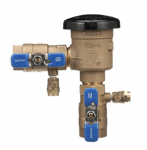So... BFP. Back Flow Preventer. They are used to protect the water source. Yours and your neighbors'. A well doesn't exempt the need, even it it's just you on your own well. Besides, if you contaminate your well, there is the underground source to consider, which could affect others "downstream."
Accidental events (like a broken water main, for example) can create a situation where water is sucked out of a contaminated source on an individual's property, back out into the public's common water source (the water main). Later, when the main is repaired, the contaminated water gets pushed back into all the surrounding houses! The contaminated source might be a pool, or a hose filling a bucket of nasty garden chemicals, or one watering a muddy garden, an improperly installed water filter or water softener, etc. A BFP keeps any water from your property from entering the public's. In your case, a BFP keeps your pool or irrigation water out of your well.
What is a BFP? Your sprinkler valve has one (anti-siphon). Your toilet has one (the air gap between your tank's filler tube and the top of the water level). Your dishwasher should have an air gap (water softeners and whole house filters are supposed to). Your outdoor hose bibs are supposed to (that little brass fitting between hose and faucet). And your well is supposed to have one. Etc. All designed to keep water from flowing the wrong way.
So, if your pool filler's outlet is well above the waterline, that's an air gap and an appropriate BFP. If that same line also has a sprinkler valve and/or a cheapie check valve type gizmo (I think you described) that's even better (though not actually necessary). You're good to go.
If your pool filler's outlet is
under the water line, then you've got some potential for a back-flow event. The sprinkler valve or check valve, located well above the water level, is good (it's to be 12" or 18" min. I think). And as long as they are functioning, and the BFP that's supposed to be at the bottom of the pipe in your well is also functioning, then you're OK. A lot would have to go wrong for a BF event to occur. But here's the rub: sprinkler valves and cheapie check valves provide no way to determine if they're working. There's no way to test them. And testing the well's BFP is not easy to do. I'm guessing you've never thought to check, or even knew it was down there (that's if there even
is one down there!). So if your well's system is not up to snuff, and your sprinkler valve's anti-siphon component is leaking, and because of the gravity feed nature of a well, you could conceivably be getting pool water in your well without even knowing. This is farfetched, of course. Just pointing out the possibility. A proper BFP for a residential water system would look something like this, which is of good quality and can be tested.

About $60 on Amazon. All bronze. Testing ports, etc.
It becomes even more important to have a good BFP valve if there are any other valves downstream (like an auto-filler), because that would mean the BFP is under constant pressure. The anti-siphon component of a sprinkler valve is on the
sprinkler side of the valve, so that it's not really ever under full pressure when used for its intended purpose, and only then when the valve is open. They can handle that. But if there is an auto-filler valve downstream, then the sprinkler valve's anti-siphon component is under constant, full-on pressure and they are not rated for that and will eventually fail (and you'll never know it happened). So when there is a second valve, it's way more important to have a high-quality BFP
that is rated for the pressure (not all are), and is testable to boot.
So there you have it. More than you ever wanted to know about BFP! You decide for yourself what level of protection you want to have based on your filler's plumbing configuration. Or you could put a good one out by the well, have it tested once in a while, and solve for your entire water system.
BTW, I got this info straight from my bud, who helped me design my pool's BFP setup. He works for the water utility of a major CA city, so he knows his stuff. Part of his job is testing local businesses' BFPs, which are required along with annual testing. (And he tests mine every so often, which makes it "convenient" for me to rag about BFP testing, right?) Residences are not required to have BFPs, but he thinks they are moving towards that in CA. They'll start with new construction and eventually mandate retrofits for all. I even called him last night for ya, because while I remembered what he thought me for a typical city neighborhood, I wasn't sure how someone on a well would be affected. Turns out someone on a well is just as vulnerable to a BF event, in not more so, as us "city folk."
 Three threaded joints for the valve & 2 had unions close, so, of course it'd be the one without and will have to make a cut to tighten. Actually adding a union will make getting that module in place easier, so probably for the best.
Three threaded joints for the valve & 2 had unions close, so, of course it'd be the one without and will have to make a cut to tighten. Actually adding a union will make getting that module in place easier, so probably for the best.






